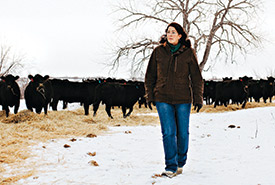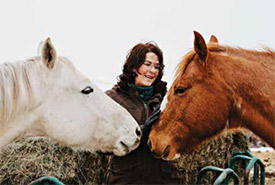A gift for the grasslands

Tamara Carter (Photo by Rachelle Hodgins)
The Weston Family Prairie Grasslands Initiative is empowering ranchers to play a critical role in conserving the few native prairie grasslands we have left
By Julie Barnes, freelance writer and editor
It’s a crisp, early December afternoon when I approach the Carter family ranch in southwest Saskatchewan. At first glance, it’s a stark winter landscape, capped in a blanket of fresh snow, disturbed only by the tracks of a Nuttall’s cottontail rabbit. But spend a little time here, and it becomes clear that these lands are brimming with biodiversity, both above and below the mineral-rich soil.
And the Carters are intent on keeping it that way. Three kilometres down the driveway, some of the Carters’ 250 black Angus cattle come into view; a dramatic contrast against the white backdrop. Just up ahead is the family homestead, perched on the crest of a hill, shrouded in majestic stands of towering conifers, green ash and box elder.
Tamara and Russ Carter are the stewards of these 2,800 hectares of native prairie grasslands. They purchased the land in 1996 and raised their children here, but the Carters’ roots run even deeper.
Russ’ family has farmed and ranched on these lands for over 100 years. Here, an interconnected web of soil microbiota, insects, plants, wildlife, cattle and humans work in harmony to maintain healthy and resilient grassland ecosystems. “It’s a gift, and it is a privilege,” says Tamara. “There’s a tremendous responsibility to care for the land. I don’t take it lightly.” Grasslands are among the world’s most endangered — and least protected — ecosystems.
By some estimations, more than 75 per cent of Canada’s prairie grasslands have been eradicated. Cropland conversion, urban sprawl and infrastructure, like highways, all play a role in their decline.
Temperate grasslands are like giant lungs,” Tamara says. “They clean the air. They filter water.” She adds that the roots of the native grasses can reach down many metres, aiding in carbon sequestration.
“People across Canada benefit from the positive impact of healthy and intact grasslands.” It’s Tamara’s “boots-on-the-ground” experience as a rancher that made her ideally suited to take on the role of director of prairie grasslands conservation for the Nature Conservancy of Canada (NCC) for the last two years to develop and lead the Weston Family Prairie Grasslands Initiative (WFPGI), the largest ever prairie investment in stewardship on Canada’s grasslands.
Although Tamara will be handing off the project, she has set it up well for success. Launched in 2021, the Stewardship Investment Program (SIP) is a four-year collaboration funded through the WFPGI. The SIP is designed to protect and conserve native prairie grasslands in Alberta, Saskatchewan and Manitoba. NCC has partnered with four land trusts to expand the program’s reach and amplify the impact: Ducks Unlimited Canada, Manitoba Habitat Heritage Corporation, Southern Alberta Land Trust Society (SALTS) and Western Sky Land Trust. Together with these land trusts, NCC is providing up to 830 grants. The funding aims to support work to maintain and enhance biodiversity outcomes on as much as 1.4 million hectares of grasslands in the Prairie provinces.

Les propriétaires de ranch peuvent jouer un rôle essentiel dans la conservation des prairies indigènes restantes au Canada (Photo de Rachelle Hodgins)
All this is thanks to the generosity of the Weston Family Foundation’s healthy landscapes portfolio, which aims to restore and protect biodiversity on Canada’s wild, agricultural and urban landscapes. Landowners who meet the eligibility requirements can apply for an NCC grant of up to $10,000 to fund projects that protect their grasslands and the species that depend on them. The funding comes at an opportune time, as ranchers are under increased financial pressure due to rapidly rising costs of fertilizer, fuel, feed and machinery.
“Everything is going up, except what we’re getting paid for our cattle. Retail prices are not at all representative of what the rancher gets paid.” Landowners can make more money converting their grasslands into cropland for growing high-value crops like canola, wheat or lentils.
“It’s really tempting if you’re not making money with cattle,” explains Tamara. Much of the country’s remaining grasslands are managed or owned by cattle producers, so ranchers like Tamara play a critical role in their stewardship. As the administrator of the SIP, she acted as a conduit between the conservation and ranching communities.
“I learned about conservation myself from NCC, and now I’m taking some of that learning back into the ranching communities and saying, ‘Hey — this is what you can do with a partnership with NCC.’” As of year two, the program has funded close to 330 projects. The development of water systems and wildlife-friendly fencing have been among the most popular projects initiated by grant recipients, says Tamara.
This excerpt originally appeared in the spring 2023 issue of the Nature Conservancy of Canada Magazine.
Explore additional content from our spring issue here >
The Nature Conservancy of Canada Magazine is distributed to NCC donors and supporters who contribute $100 or more per year.




